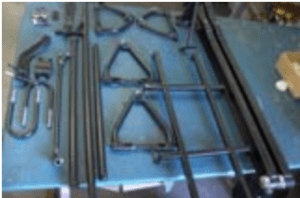BENEFITS OF POWDER COATING
IT’S HIGHLY DURABLE.
Powder coating is more resistant to chipping, cracking, scratching, wearing and fading than any other finish.
IT LOOKS GREAT.
Powder coating is available in over a thousand colors and many different texture options. Colors stay bright and vibrant longer with a smooth and uniform finish.
IT’S ENVIRONMENTALLY FRIENDLY.
Powder coating is a pollution-free process that uses no volatile organic compounds. There is no harm to the environment, and powder coated surfaces are nontoxic.




 The best way to clean your powder coated parts is to use warm soapy water. Liquid dish soap works well. You should never use harsh cleaners, such as Greased Lightning®, acid, methyl ethyl keytone and acetone. There are many more chemicals that will cause damage to the coating, so please read all warnings and instructions for the cleaners that you use. If you are unsure if your cleaning chemicals will cause damage, feel free to call or email us and we can help you choose a safe cleaning product.
The best way to clean your powder coated parts is to use warm soapy water. Liquid dish soap works well. You should never use harsh cleaners, such as Greased Lightning®, acid, methyl ethyl keytone and acetone. There are many more chemicals that will cause damage to the coating, so please read all warnings and instructions for the cleaners that you use. If you are unsure if your cleaning chemicals will cause damage, feel free to call or email us and we can help you choose a safe cleaning product. Powder coating is an environmentally friendly process that uses no volatile organic compounds (VOC’s), unlike solvent-based wet paint systems. Our powder coating protocol exceeds all EPA standards and is a safe and clean finishing alternative to toxic chemicals. With powder coating, there is no off gassing (the release of chemicals into the air through evaporation, usually detected by the harsh chemical smell when the paint is drying). This means there is no danger to the environment or to humans who come in contact with powder coated surfaces. This is especially important for applications where the parts will be in close proximity to people or animals. Additionally, unused or over-sprayed powder can be recovered, so waste is minimal and can be disposed of easily and safely.
Powder coating is an environmentally friendly process that uses no volatile organic compounds (VOC’s), unlike solvent-based wet paint systems. Our powder coating protocol exceeds all EPA standards and is a safe and clean finishing alternative to toxic chemicals. With powder coating, there is no off gassing (the release of chemicals into the air through evaporation, usually detected by the harsh chemical smell when the paint is drying). This means there is no danger to the environment or to humans who come in contact with powder coated surfaces. This is especially important for applications where the parts will be in close proximity to people or animals. Additionally, unused or over-sprayed powder can be recovered, so waste is minimal and can be disposed of easily and safely.